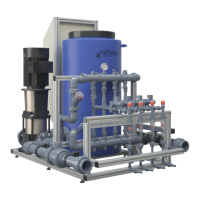NETAFLEX™ 3G USER MANUAL
17
TROUBLESHOOTING
Controller warnings
• Low EC
• High pH
• Low fertilizer/acid flow rate
Rotameter reading
• Low fertilizer/acid flow rate
Action
1) Check that there is fertilizer/acid solution in the stock tank
A
.
2) Check that the stock tank manual valve
B
is in the OPEN position.
3) Check that the fertilizer/acid filter
C
is clean - If not, it should be dismantled and thoroughly cleaned.
4) Check the fertilizer/acid line
D
(from the stock tank to the dosing channel) for leaks and breaches
and make sure all the connectors are tightened.
5) Make sure the dosing channel's needle valve
E
is open according to the the initial setting.
6) Visually check the needle valve
E
for chemical damage (internal deformation).
If internal deformation is present - replace the needle valve.
7) Visually check the needle valve
E
for clogging.
If clogging is present - thoroughly clean the needle valve.
8) Check that the dosing valve
F
is functioning:
With the controller in MANUAL mode, set the dosing valve
F
to ON (see the Controller Manual).
The LED on the dosing valve should be lit.
If it is not - have a qualified electrician check the dosing valve's cable for electrical continuity.
If the cable is in working order - check the controller (see the Controller Manual).
If the controller and the cable are in working order - toggle the dosing valve
F
to OFF and again to ON
in the controller (
see the Controller Manual
). A "Click" should be heard from the dosing valve with each
toggle - If a "Click" is not heard, replace the dosing valve (consult your local Netafim™ representative).
If a "Click" is heard and the dosing valve
F
still does not open - disconnect the dosing valve from the
dosing channel and with the dosing valve set to ON in the controller (see the Controller Manual),
check for clogging by injecting water at low pressure through the dosing valve.
If there is clogging - thoroughly clean the dosing valve
F
with running water.
If there is no clogging and the dosing valve
F
still does not open - replace it
(consult your local Netafim™ representative).
If after implementing all the above steps the malfunction is still not fixed -
9) Disconnect the Venturi
G
from the manifolds and from the dosing channel and check it for clogging,
visually and by injecting water at low pressure through it.
If there is clogging - thoroughly clean the Venturi
G
with running water.
10) Visually check the Venturi
G
for chemical damage (internal deformation).
If internal deformation is present - replace the Venturi (consult your local Netafim™ representative).
If after implementing all the above steps the malfunction is still not fixed - consult
your local Netafim™
representative
.

